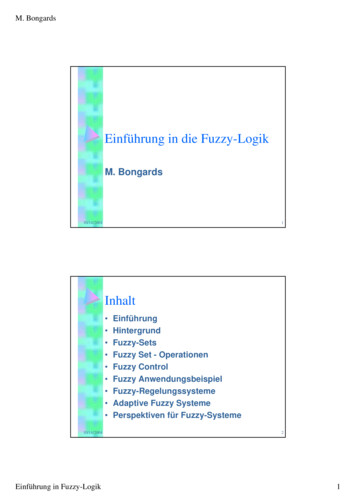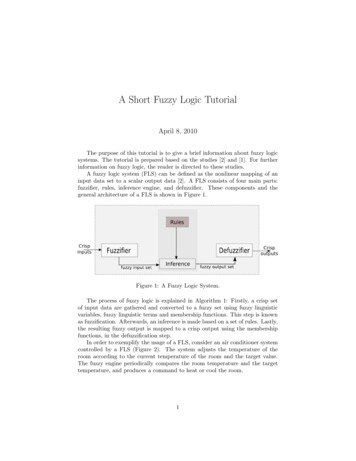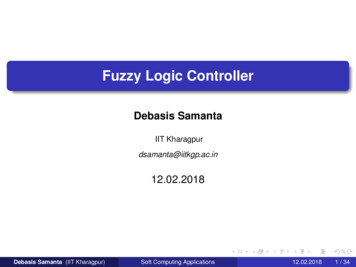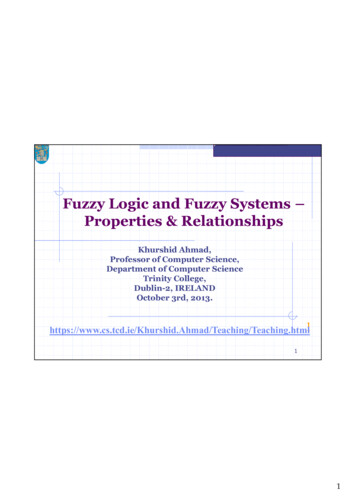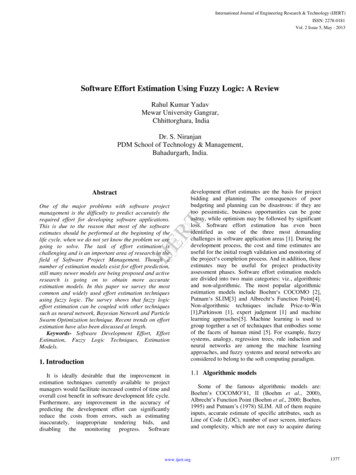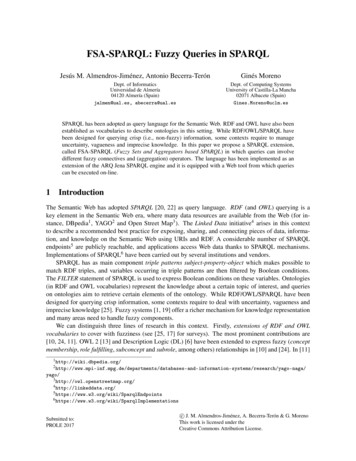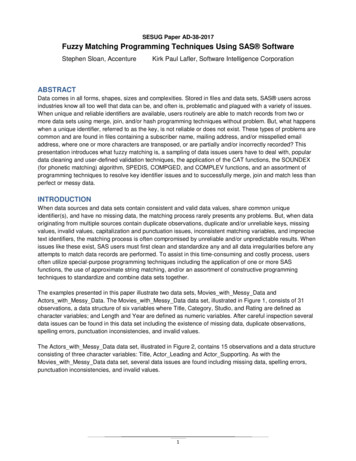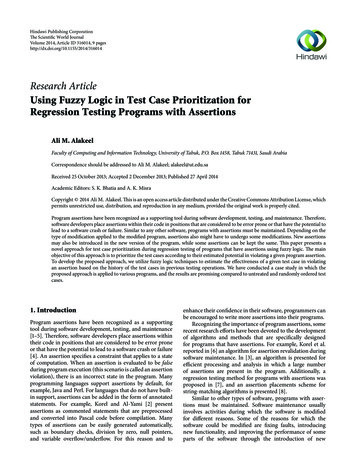
Transcription
Hindawi Publishing Corporation e Scientific World JournalVolume 2014, Article ID 316014, 9 pageshttp://dx.doi.org/10.1155/2014/316014Research ArticleUsing Fuzzy Logic in Test Case Prioritization forRegression Testing Programs with AssertionsAli M. AlakeelFaculty of Computing and Information Technology, University of Tabuk, P.O. Box 1458, Tabuk 71431, Saudi ArabiaCorrespondence should be addressed to Ali M. Alakeel; alakeel@ut.edu.saReceived 25 October 2013; Accepted 2 December 2013; Published 27 April 2014Academic Editors: S. K. Bhatia and A. K. MisraCopyright 2014 Ali M. Alakeel. This is an open access article distributed under the Creative Commons Attribution License, whichpermits unrestricted use, distribution, and reproduction in any medium, provided the original work is properly cited.Program assertions have been recognized as a supporting tool during software development, testing, and maintenance. Therefore,software developers place assertions within their code in positions that are considered to be error prone or that have the potential tolead to a software crash or failure. Similar to any other software, programs with assertions must be maintained. Depending on thetype of modification applied to the modified program, assertions also might have to undergo some modifications. New assertionsmay also be introduced in the new version of the program, while some assertions can be kept the same. This paper presents anovel approach for test case prioritization during regression testing of programs that have assertions using fuzzy logic. The mainobjective of this approach is to prioritize the test cases according to their estimated potential in violating a given program assertion.To develop the proposed approach, we utilize fuzzy logic techniques to estimate the effectiveness of a given test case in violatingan assertion based on the history of the test cases in previous testing operations. We have conducted a case study in which theproposed approach is applied to various programs, and the results are promising compared to untreated and randomly ordered testcases.1. IntroductionProgram assertions have been recognized as a supportingtool during software development, testing, and maintenance[1–5]. Therefore, software developers place assertions withintheir code in positions that are considered to be error proneor that have the potential to lead to a software crash or failure[4]. An assertion specifies a constraint that applies to a stateof computation. When an assertion is evaluated to be falseduring program execution (this scenario is called an assertionviolation), there is an incorrect state in the program. Manyprogramming languages support assertions by default, forexample, Java and Perl. For languages that do not have builtin support, assertions can be added in the form of annotatedstatements. For example, Korel and Al-Yami [2] presentassertions as commented statements that are preprocessedand converted into Pascal code before compilation. Manytypes of assertions can be easily generated automatically,such as boundary checks, division by zero, null pointers,and variable overflow/underflow. For this reason and toenhance their confidence in their software, programmers canbe encouraged to write more assertions into their programs.Recognizing the importance of program assertions, somerecent research efforts have been devoted to the developmentof algorithms and methods that are specifically designedfor programs that have assertions. For example, Korel et al.reported in [6] an algorithm for assertion revalidation duringsoftware maintenance. In [3], an algorithm is presented forefficient processing and analysis in which a large numberof assertions are present in the program. Additionally, aregression testing method for programs with assertions wasproposed in [7], and an assertion placements scheme forstring-matching algorithms is presented [8].Similar to other types of software, programs with assertions must be maintained. Software maintenance usuallyinvolves activities during which the software is modifiedfor different reasons. Some of the reasons for which thesoftware could be modified are fixing faults, introducingnew functionality, and improving the performance of someparts of the software through the introduction of new
2algorithms. A study in [9] shows that there is a probabilityof 50–80% of introducing faults to the modified softwareduring software maintenance. Therefore, regression testingis performed during software maintenance for the purposeof testing the modified software to ensure its correctnessafter maintenance operations. There are many regressiontesting methods, which could be classified as specificationbased or code-based. Specification-based regression testingstrategies, for example, [10–12], generate test cases based onthe specification of the software, while code-base regressiontesting, for example, [7, 13–16] strategies depend on thesoftware structural elements to generate the test cases.Regression testing is very labor intensive and could beresponsible for approximately 50% of software maintenancecosts [17]. In a systematic software development environment, all of the types of regression testing methods usuallyinvolve the usage of an original test suite, which is used forthe purpose of testing the original program before it hasbeen modified. Therefore, many regression testing methodsusually utilize an existing previous test suite in some formor another during regression testing. For example, a simpleregression testing strategy would rerun an existing testingsuite, on an as-is basis, on the modified program, whileintroducing new test cases to test new features. Although thismethod is simple, it is not practical for commercial softwarebecause an existing test suite is usually very large and couldtake weeks to rerun on the new modified software. Therefore,regression test selection techniques, for example, [18], testsuite minimization techniques, for example, [19], and test caseprioritization techniques, for example, [20–27], are proposedin the literature to mitigate the cost that is associated withrunning the entire suite of previous, existing tests.The main objective of regression test selection techniques and test suite minimization techniques is to selecta representative subset of the original test suite by usinginformation about the original program, its modified versionand the original test suite. It should be noted that boththe regression test selection and test suite minimizationtechniques eliminate some elements of the original test suite,which could undermine the performance of these techniques.Test case prioritization techniques, however, order elementsof the original test suite based on a given criterion. Furthermore, test case prioritization techniques do not involvethe selection of a subset of the original test suite. In thispresentation, we will concentrate on test case prioritizationtechniques; therefore, regression test selection and test suiteminimization will not be discussed any further.With regard to programs with assertions, assertions couldalso undergo some modifications during maintenance. Someassertions could be modified, while new assertions couldalso be introduced into the new version of the program.Additionally, some assertions could be kept the same as inthe original program.This paper presents a novel approach for test case prioritization during regression testing of programs with assertionsusing fuzzy logic. The main objective of this approach is toprioritize test cases according to their estimated potentialto violate a given program assertion. Note that it has beenshown in [2] that violating an assertion implies revealingThe Scientific World Journala programming fault. To develop the proposed test caseprioritization approach, we utilize fuzzy logic techniques[28, 29] to measure the effectiveness of a given test case inviolating an assertion based on the history of the test casesin previous testing operations. The proposed method buildson previous research in the fields of assertions-based softwaretesting and assertions revalidation, as reported in [6, 7].The remainder of this paper is organized as follows.Related work and background is discussed in Section 2. Wepresent our proposed fuzzy test case prioritization model inSection 3. To evaluate our proposed approach, a case study ispresented in Section 4, and conclusions and future work arediscussed in Section 5.2. Related WorkPrevious research on using fuzzy logic for the purpose oftest case prioritization is scant. In [30], a fuzzy expert systemis reported in which the system is used during regressiontesting of a telecommunication application. To build therequired knowledge base for the expert system reported inthis research, the researchers had to acquire knowledge fromdifferent sources, such as customer profiles, past test results,system failure rates, and the history of system architecturechanges. Although this expert system has shown promisingresults with respect to the specific application that it wasdesigned for, it is necessary to acquire a new knowledgebase for new applications. The proposed test case selectionmodel in [30] treats the software under test as a black box;therefore, it cannot be used for the purpose of regressiontesting programs with assertions.Recently, a test case prioritization concept that is based onsoftware agents and fuzzy logic was reported in [26]. In thatresearch, software agents are used to gather information fromdifferent sources related to the environment surroundingthe software. These sources include an architectural model,test management tool, fault management tool, and changemanagement tool. After analyzing data that is gathered fromvarious sources, this approach assigns each software modulea test importance (TI) value in the range of 1 to 10. A highTI value indicates that this module should be tested morethan another module with a lower TI value. Additionally,this approach assigns each test case a local priority (LP)value based on its ability to cover a certain software module.In the end, test cases are ordered based on global priority(GP) values, which are estimated by combining the values ofthe module TI values and test case LP values. The conceptpresented in [26] is interesting; however, the amount ofdata that must be gathered and analyzed by software agentscould be very large and costly for large industrial software.Additionally, there has not been any information providedabout what type of fuzzy logic technique has been usedto estimate the TI, LP, and GP values. Furthermore, theprioritization approach reported in [5] prioritizes test casesbased on their coverage ability on the module level and not onthe statement level. This arrangement is a drawback becauseprogram faults are usually caused by errors at the statementlevel and not at the module level, which makes this approach
The Scientific World Journaldifficult to adapt and compare with most of the existing testcase prioritization methods.2.1. Test Case Prioritization. The main goal of the prioritization techniques is to increase the probability of detectingfaults at an earlier stage of testing [20–27]. Additionally, thetest case prioritization technique objective is the utilizationof previous test cases for the purpose of future testing. Asstated in [21], there could exist several goals of test caseprioritization, such as (1) to increase the test suite faultdetection rate; (2) to minimize the time required to satisfy atesting coverage criterion; (3) to enhance a tester’s confidencein the reliability of the software in a shorter time period; (4)to be able to detect risky faults as early as possible; and (5)to increase the chances of detecting faults that are related tosoftware modification during regression testing.In [21], an extensive study of nine different test case prioritization techniques was presented and compared accordingto their ability to perform fault detection during regressiontesting. During that study, a detection rate function is used toreorder test cases according to their ability to reveal programfaults during regression testing. In [23], the Extended FiniteState Machine (EFSM) system model is proposed to be usedinstead of real programs in order to apply the same techniquepresented in [24] and to reduce the cost of running testcases with real programs. Bryce et al. presented in [22] a testprioritization model for Event-Driven software. This modelconcentrates on testing those parts that are related to theinterface in GUI applications. Several experimental resultshave been reported in [20], which study the cost-benefitsof applying test case prioritization techniques. Recently, amethod for test case prioritization using genetic algorithmswas presented in [27]. In that research, a genetic algorithm isproposed to order the test cases according to their historicaldata with regard to their abilities to perform fault detection.A survey study of different test case prioritization techniquesand mythologies has been reported in [25].2.2. Regression Testing for Programs with Assertions. Thissection briefly introduces the concept of regression testingfor programs that have assertions. For more detail, thereader is referred to [7]. Given an original program 𝑃𝑜and a modified version of this program 𝑃𝑚 , let 𝐴 𝑜 {𝑎𝑜1 , 𝑎𝑜2 , 𝑎𝑜3 , . . . , 𝑎𝑜𝑛 } be a set of assertions found in 𝑃𝑜 and𝐴 𝑚 {𝑎𝑚1 , 𝑎𝑚2 , 𝑎𝑚3 , . . . , 𝑎𝑚𝑧 } be a set of assertions foundin 𝑃𝑚 . Let 𝑉 𝐴 𝑚 be a set of assertions that arenominated for revalidation [6], using previous test suites,during the process of regression testing the modified version 𝑃𝑚 . Depending on the type of modification that isapplied to the modified version 𝑃𝑚 , some assertions mighthave been kept the same; some assertions might have beenmodified, and new assertions might have been introduced.The main objective of regression testing for programs thathave assertions, as reported in [7], is to reduce the cost ofregression testing of programs that have assertions throughthe utilization of previous test suites that are used duringthe initial development process. Furthermore, this methodconcentrates on assertions that are kept the same and thosethat are modified; new assertions are not covered because new3test cases must be generated to explore these assertions. Thismethod is presented in more detail in the next paragraph.Let 𝑎𝑚𝑖 𝐴 𝑚 be an assertion that is found in 𝑃𝑚 .Assume that 𝑎𝑚𝑖 was not changed from its original form in𝑃𝑜 nor was it affected by the modifications introduced toproduce 𝑃𝑚 . Therefore, 𝑎𝑚𝑖 will be nominated by the proposedapproach, to belong to the set 𝑉; that is, 𝑎𝑚𝑖 𝑉. Supposethat assertions-oriented testing, as reported in [2], has beenperformed on the original version 𝑃𝑜 , and a set of test caseswere generated during this process and were kept for laterusage during regression testing. In particular, let 𝑎𝑜𝑘 𝐴 𝑜be an assertion that was found in 𝑃𝑜 , and let 𝑇(𝑎𝑜𝑘 ) {𝑡𝑘1 , 𝑡𝑘2 , 𝑡𝑘3 , . . . , 𝑡𝑘𝑟 } be the set of test cases that were generatedto explore this assertion during the application of assertionoriented testing [2] on the original program 𝑃𝑜 . To ensurethat faults are not introduced during the production of themodified version 𝑃𝑚 , regression testing must be performedon 𝑃𝑚 , which has a set of assertions 𝐴 𝑚 . Given 𝑎𝑜𝑘 𝐴 𝑜 , 𝑇(𝑎𝑜𝑘 ) {𝑡𝑘1 , 𝑡𝑘2 , 𝑡𝑘3 , . . . , 𝑡𝑘𝑟 } and 𝑎𝑚𝑖 𝑉, it hasbeen shown in [7] that the old test suit, 𝑇(𝑎𝑜𝑘 ), could beused to revalidate assertion 𝑎𝑚𝑖 during regression testing ofthe modified version 𝑃𝑚 . Furthermore, it has been shownthat using previous test suites to revalidate assertions coulduncover faults in the modified version if these revalidatedassertions were violated. More specifically, faults for whichthe assertions were originally designed to guard against in theoriginal version of the program could have been reintroducedin the modified version 𝑃𝑚 [7].Although the regression testing method for programswith assertions, as presented in [7], could succeed in utilizingprevious test suites and therefore reduce testing time, thismethod still considers using all test cases found in theprevious test suite. Therefore, the method presented in [7]might not perform well in the presence of a large previous testsuite with thousands of test cases. In this paper, we proposea test case prioritizing method that uses fuzzy logic conceptsto select only a subset of the previous test cases. The proposedmethod is described in Section 3.2.3. Assertions Revalidation. To address assertions in modified programs during regression testing, an assertions revalidation model was proposed in [6]. That approach is based ondata dependency analysis and program slicing. In particular,that approach is based on the computation of a static slice[31, 32] for each assertion found in both the original and themodified program. These program slices are then comparedto decide which assertions are to be revalidated. Althoughthis method is very useful in identifying assertions that mustbe revalidated, new test cases to revalidate the assertions aregenerated from scratch for each assertion. For industrial sizeprograms with a possibly large number of assertions, thisapproach could be very expensive.2.4. Fuzzy Logic Background. In our daily life, we use wordsand terms that are vague or fuzzy, such as:“The server is slow,”“The weather is hot,” or“John is tall.”
4The Scientific World JournalFuzzy Logic concepts, for example, [28, 29], give usthe ability to quantify and reason with words that haveambiguous meanings, such as the words (slow, hot, and tall)mentioned above. In fuzzy sets [28], an object can partiallybelong to a set, as opposed to classical or “crisp” sets, inwhich an object can belong to a set or not. For example, ina universe of heights (in feet) for adult people defined as 𝜇 {5, 5.5, 6, 6.5, 7, 7.5, 8}, a fuzzy subset TALL can be defined asfollows:TALL [0/5, 0.125/5.5, 0.6/6, 0.875/6.5, 1/7, 1/7.5, 1/8] .(1)In this example, the degree of membership for themembers of the universe, 𝜇, with respect to the set TALL canbe interpreted as the value “6” belongs to the set TALL 60%percent of the time, while the value 8 belongs to the set TALLall of the time.3. A Fuzzy Test Case Prioritization TechniqueThe main objective of the proposed approach in this paper isto prioritize test cases according to their effectiveness whenviolating an assertion. More specifically, given a set of testcases, our objective is to reorder these test cases according totheir estimated potential to violate a given program assertion.Note that it has been shown in [2] that violating an assertioncan strongly imply uncovering program faults.More formally, the problem investigated in this researchcan be stated as follows. Given an original program 𝑃𝑜and a modified version of this program 𝑃𝑚 , let 𝐴 𝑜 {𝑎𝑜1 , 𝑎𝑜2 , 𝑎𝑜3 , . . . , 𝑎𝑜𝑛 } be a set of assertions found in 𝑃𝑜 , andlet 𝐴 𝑚 {𝑎𝑚1 , 𝑎𝑚2 , 𝑎𝑚3 , . . . , 𝑎𝑚𝑧 } be a set of assertions foundin 𝑃𝑚 . Suppose that we are performing regression testingfor the modified version 𝑃𝑚 , while using some regressiontesting method, for example, [7]. Let 𝑇𝑜 {𝑡1 , 𝑡2 , 𝑡3 , . . . , 𝑡𝑞 }be a previous test suite that was used during the processof assertion-oriented test data generation [2] of the originalversion 𝑃𝑜 . Given an assertion 𝑎𝑜𝑘 𝐴 𝑜 and a test suite𝑇(𝑎𝑜𝑘 ) {𝑡𝑘1 , 𝑡𝑘2 , 𝑡𝑘3 , . . . , 𝑡𝑘𝑟 }, which was generated to exploreassertion 𝑎𝑜𝑘 during the application of assertion-orientedtesting [2] on the original program 𝑃𝑜 . Our goal is to reorderthe set 𝑇(𝑎𝑜𝑘 ) according to the effectiveness of a given test case𝑡𝑘𝑗 𝑇(𝑎𝑜𝑘 ) to violate a given program assertion 𝑎𝑚𝑟 𝐴 𝑚during the regression testing process of the modified version𝑃𝑚 . We call the following effectiveness: Assertion ViolatingPotential (AVP) of a test case 𝑡𝑘𝑗 , which is represented asAVP(𝑡𝑘𝑗 ). To estimate AVP(𝑡𝑘𝑗 ), we analyze the performanceof each 𝑡𝑘𝑗 in previous tests of the original program 𝑃𝑜together with the revalidations [6] history of assertions foundin the modified version 𝑃𝑚 .We propose using the model that is shown in Figure 1,which can be described as follows. First, we analyze both 𝑃𝑜and 𝑃𝑚 to classify the assertions, 𝐴 𝑚 , that were found in 𝑃𝑚with respect to how much the modifications placed in 𝑃𝑚had affected those assertions. To perform this analysis, weuse an assertions revalidations model [6] to classify the setof assertions, 𝐴 𝑚 , which are found in 𝑃𝑚 into three differentsets: “Affected,” “Partially Affected,” and “Not Affected.” ThisModified version ofPo (i.e. Pm )Original programwith assertions PoAssertions revalidation tedAssertions tagging process in PmPm with tagged assertionsA previous test suitegenerated for PoProposed fuzzy logic model forregression testingFigure 1: Fuzzy Regression Testing Model for programs withassertions.categorization is based on how much each assertion hasbeen affected by changes that were made in the modifiedprogram version 𝑃𝑚 . Because it is very difficult to expressthis categorization with normal sets that dictate drawingcrisp lines between each category, we create a fuzzy set [25]called AFFECTED in which each assertion will only belongto the set by a membership value in the range [0, 1]. Theassignment of membership values (grades) is based on the 𝑆function [33], which is shown in (4) and will be describedshortly. Note that other fuzzy clustering techniques otherthan the 𝑆-function can be used for the purpose of buildingup fuzzy sets and the assignment of membership functions.In this research, our estimation of the modifications incurredon each assertion, 𝐴, is based on the number of variablesmodified in this assertion. More formally, let 𝑁𝐴 be thenumber of variables that constitute an assertion 𝐴. Based onour empirical experiments, 𝑆-function parameters (𝛼, 𝛽, and𝛾 ) are expressed as follows:𝛼 0,𝛽 0.4 𝑁𝐴,(2)𝛾 0.8 𝑁𝐴.For example, if we have assertion 𝐴 with five variables,that is, 𝑁𝐴 5, then we will have the following 𝑆function: 𝑆𝐴 (𝑥; 0, 2, 4). Based on the number of variables,𝑥, modified in assertion 𝐴, we substitute this number in𝑆𝐴 (𝑥; 0, 2, 4) to obtain the membership value for assertion 𝐴,𝑚𝐴 (AFFECTED), in the fuzzy set AFFECTED. Suppose thatin this example only one variable was modified in assertion 𝐴;the membership of 𝐴 will be computed as 𝑚𝐴(AFFECTED) 0.125. On the other hand, if three variables were modified,then the membership of 𝐴 will be 𝑚𝐴 (AFFECTED) 0.875,and so on.Based on the results of assertions categorization performed in the first step, the next step is to categorize test cases
The Scientific World Journal5according to their expected effectiveness during regressiontesting of the modified version of the program, that is, 𝑃𝑚 .Because the “effectiveness” of a test case is a fuzzy term thatis very hard to measure with a crisp value, we propose usingfuzzy logic techniques to address measuring the effectivenessof a given test case. For this purpose, we create a fuzzy setcalled EFFECTIVENESS. Test cases will belong to the fuzzyset EFFECTIVENESS with a membership value or gradethat corresponds to their Assertion Violating Potential (AVP)values. More specifically, let 𝑡𝑘𝑗 𝑇(𝑎𝑜𝑘 ) be a test case that wasused to explore assertion 𝑎𝑜𝑘 𝐴 𝑜 during the initial testingof a program 𝑃𝑜 . To measure the effectiveness of 𝑡𝑘𝑗 (withAVP(𝑡𝑘𝑗 )) in violating the corresponding assertion 𝑎𝑚𝑟 𝐴 𝑚in the modified version 𝑃𝑚 during the process of regressiontesting the program 𝑃𝑚 , we use the following formula:AVP (𝑡𝑘𝑗 ) 1 ma𝑚𝑟 (AFFECTED) ,(3)where ma𝑚𝑟 (AFFECTED) is the membership values of assertion 𝑎𝑚𝑟 in the fuzzy set AFFECTED.Therefore, test cases related to any assertion 𝑎𝑜𝑘 𝐴 𝑜 ,where 𝑎𝑜𝑘 belongs to the fuzzy set AFFECTED with a highmembership value, will have low effectiveness in exploringthe corresponding assertion in the modified version of theprogram. Similarly, test cases that are related to any assertion𝑎𝑜𝑘 𝐴 𝑜 , where 𝑎𝑜𝑘 belongs to the fuzzy set AFFECTEDwith moderate grade values, will have moderate effectivenessin exploring the corresponding assertion in the modifiedversion of the program. By the same token, test cases relatedto any assertion 𝑎𝑜𝑘 𝐴 𝑜 , where 𝑎𝑜𝑘 belongs to the fuzzyset AFFECTED with low membership values, will have higheffectiveness in exploring the corresponding assertion in themodified version of the program.3.1. The 𝑆-Function. 𝑆-functions can be described as follows[33]:(i) A mathematical function that is used in fuzzy sets asa membership function.(ii) A simple but valuable tool in defining fuzzy functions,such as the word “tall”.(iii) The objects 𝑥 are elements of some universe 𝑋. Inthis research, 𝑥 represents the set of test cases that weare addressing during our prioritization mechanism,where these test cases are elements of the universe ofpossible program input data.(iv) 𝛼, 𝛽, and 𝛾 are parameters that can be adjusted tofit the desired membership data. The parameter 𝛼represents the minimum boundary, and 𝛾 representsthe maximum boundary. The parameter 𝛽 is themiddle point between 𝛼 and 𝛾 and is computed as(𝛼 𝛾)/2.The 𝑆-function0{{{{𝑥 𝛼 2{{2({{ 𝛾 𝛼)𝑆 (𝑥; 𝛼, 𝛽, 𝛾) {{𝑥 𝛼 2{{1 2(){{𝛾 𝛼{{{1for 𝑥 𝛼for 𝛼 𝑥 𝛽(4)for 𝛽 𝑥 𝛾for 𝑥 𝛾.Depending on the application, a membership functioncan be controlled from different sources [28]. For example, in an expert system, the membership function will beconstructed based on the experts’ opinion modeled by thesystem. In this research, values of the parameters 𝛼 and𝛾 are determined after experimentation with the proposedapproach.For illustration, consider the program shown in Program1 to be the original version 𝑃𝑜 , and its modified version,𝑃𝑚 , is the program represented in Program 2. The functionof 𝑃𝑜 is to compute the minimum and maximum of anarray of integers. Suppose that 𝑃𝑜 is modified to introducea new functionality, which is to compute the sum of thearray elements. This modification is shown in Program 2.Furthermore, suppose that during this modification, a faultis introduced in which statement number 12 of the modifiedversion is “incorrectly” misplaced in an incorrect position.This seeded fault will cause the program of (4) to computethe maximum element incorrectly for certain combinationsof the array’s elements. Note that the seeded fault could beuncovered through the violation of assertion #2, which isshown in statement number 13 of Program 2.Using our notation above, let the identifiers “𝑎𝑜2 ” and“𝑎𝑚2 ” be used to represent assertion number 2 of Program1 and assertion number 2 of Program 2, respectively. Notethat the text of these assertions is identical in both versionsof the program. Suppose that during the original applicationof assertion-oriented test data generation [2] on the originalversion of Program 1, a test suite, 𝐴(𝑎𝑜2 ), is produced duringthe exploration of assertion 𝑎𝑜2 of Program 1. Suppose that𝐴(𝑎𝑜2 ) is composed of five test cases, as follows:𝑡21 (10, [17, 645, 900, 3, 88, 24, 190, 10, 1003, 115]) ,𝑡22 (10, [600, 200, 10000, 7, 99, 88, 42, 2000, 100, 28]) ,𝑡23 (10, [101, 5202, 700, 1, 32, 11, 270, 10, 575, 9]) ,𝑡24 (10, [ 765, 33, 2009, 16, 20, 113, 800, 19, 1, 99]) ,𝑡25 (10, [ 301, 2045, 760, 10, 609, 24, 21, 6, 14, 912]) .(5)Note that assertions-oriented testing [5] is originallyproposed to be used after other forms of traditional softwaretesting, such as black box (e.g., boundary value analysis) andwhite box (e.g., branch coverage), to increase the confidencein the software under consideration. Therefore, the test casesused in this example are only for the purpose of assertionoriented testing [5]; hence, invalid test cases (e.g., boundaryvalue analysis) are not included in the test suite presentedabove in this example.
6The Scientific World Journal(1) public int computeMinMax O(int elements, int Data[]){int inData[] new int[50]; int 𝑖, 𝑗, min 0, max 0;// Assuming a PreCondition of: “0 elemetns 10”(2), (3) for (𝑗 0; 𝑗 Data.length; 𝑗 ) inData[𝑗] Data[𝑗];(4)if (elements 0 && elements 10){(5)min inData[0];(6)max inData[0];(7)𝑖 1;(8)while (𝑖 Data.length){(9) assert (i 0 && i Data.length) // assertion #1(10), (11)if (min inData[𝑖]) min inData[𝑖];(12) assert (i 0 && i Data.length) // assertion #2(13), (14)if (max inData[𝑖]) max inData[𝑖];(15)𝑖 ;}(16) System.err.println(“\𝑛Min is:” min “ Max is:” max);(17) System.err.println(18) return 1;}(19) else{(20) if (elements 0)(21)System.err.println(“Empty array provided!”);(22)else System.err.println(“Violation of precondition. Out ofrange array!!! Elements:” elements);(23)return 1;}} // ComuteMinMax Oprogram 1: A sample Java program with assertions.Note that assertions-oriented testing [5] is originallyproposed to be used after other forms of traditional softwaretesting, such as black box (e.g., boundary value analysis) andwhite box (e.g., branch coverage), to increase the confidencein the software under consideration. Therefore, test cases usedin this example are only for the purpose of assertion-orientedtesting [5]; hence, invalid test cases (e.g., boundary valueanalysis) are not included in the test suite presented above inthis example.Because assertion 𝑎𝑚2 in the program of Program 2 isidentical to assertion 𝑎𝑜2 of the original version of Program1, and because 𝑎𝑚2 is not affected by the modifications [6]introduced to 𝑃𝑚 in Program 2, the test suite generated toexplore assertion 𝑎𝑜2 , that is, 𝐴(𝑎𝑜2 ), could be used to exploreassertion 𝑎𝑚2 during the regression testing of 𝑃𝑚 . Note that, inthis example, only two test cases, 𝑡23 and 𝑡25 , in 𝐴(𝑎𝑜2 ) have thepotential of violating assertion number 2 of Program 2, whichresults in uncovering the fault in 𝑃𝑚 . It should be noted thatassertion 𝑎𝑚2 can only be violated by test cases that place themaximum element in the second position of the input array.As a
prioritization model for Event-Driven so ware. is model concentrates on testing those parts that are related to the interface in GUI applications. Several experimental results have been reported in [ ], which study the cost-bene ts of applying test case prioritization techniques. Recently, a method for test case prioritization using genetic .
